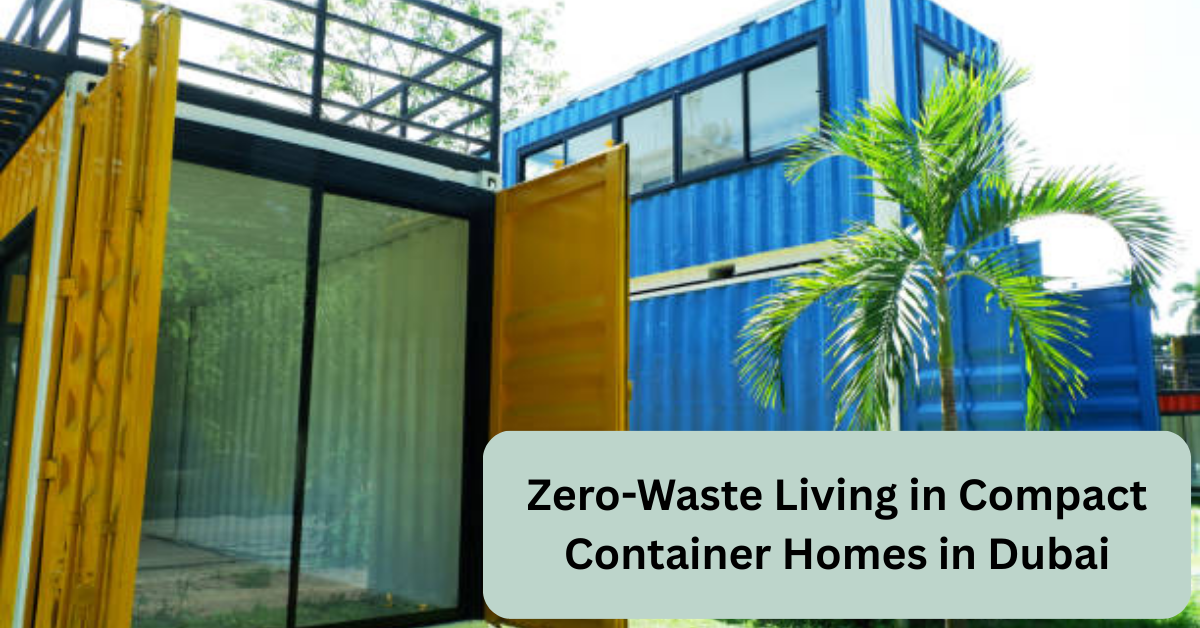As the world collectively shifts toward more sustainable living solutions, the rise of zero-waste lifestyles combined with eco-conscious housing has created a new trend: zero-waste living in compact container homes. These homes are not only a symbol of innovation but also a practical answer to urban space constraints and environmental challenges. The transformation of shipping containers into stylish, energy-efficient homes is inspiring people across the globe, including in regions like Dubai, where container conversion is gaining significant attention.This explores how zero-waste principles are applied to converted container house, what makes them suitable for sustainable lifestyles, and how this trend is shaping the future of housing.
What Is Zero-Waste Living?
Zero-waste living is a lifestyle that minimizes the amount of waste an individual or household sends to landfills. The idea is rooted in the 5 R’s of waste management: Refuse, Reduce, Reuse, Recycle, and Rot. In essence, it’s about creating a circular life cycle for materials and reducing reliance on disposable, non-biodegradable products.
When aligned with residential architecture, this philosophy significantly influences building materials, space design, energy usage, and waste disposal systems.
Why Choose a Converted Container House for Zero-Waste Living?
Converted container houses are repurposed steel shipping containers redesigned into livable, fully functional homes. These compact spaces are ideal for sustainable lifestyles due to several reasons:
1. Repurposing Waste as a Home
Shipping containers are often discarded after a few uses, contributing to industrial waste. Turning them into homes gives these steel structures a second life. This aligns perfectly with the zero-waste principle of reuse.
2. Smaller Footprint
Container homes, by design, are compact. A smaller living space naturally limits consumption and waste generation, making it easier for residents to live minimally and consciously.
3. Modular Flexibility
Container structures can be modified, stacked, and expanded. This modular approach means homeowners can adapt their space over time without excessive construction or demolition, reducing waste significantly.
Designing a Zero-Waste Container Home
Creating a zero-waste living environment within a container home starts with intentional planning. Here are several design choices that help support sustainable living.
1. Eco-Friendly Insulation and Materials
Use insulation made from recycled denim, sheep wool, or cork instead of synthetic options. For interiors, opt for reclaimed wood, bamboo, or other biodegradable, locally sourced materials.
2. Natural Ventilation and Lighting
Design the container to allow cross-ventilation and maximize daylight. Strategically placed windows and skylights reduce the need for artificial lighting and cooling systems.
3. Modular Furniture
Choose multi-functional furniture that saves space and reduces the need for multiple items. A fold-out bed that doubles as a sofa or tables that collapse into walls are both sustainable and practical.
4. Composting Toilets and Water Recycling
A true zero-waste setup integrates water-saving appliances, greywater recycling systems, and composting toilets that minimize water consumption and waste output.
Waste Management Systems in Compact Container Homes
Zero-waste isn’t just about reducing solid waste—it also involves water and energy conservation. Here’s how residents can build sustainable waste management systems into their homes:
1. On-site Composting
Create a space outside or beneath the container to compost kitchen scraps and biodegradable materials. This compost can be used for rooftop or vertical gardening.
2. Rainwater Harvesting
Install rainwater collection systems to water plants, flush toilets, and even supplement laundry needs. Filtering mechanisms can make collected water usable for multiple purposes.
3. Greywater Recycling
Repurpose water from sinks, showers, and washing machines for irrigation. This helps reduce freshwater consumption significantly.
4. Smart Energy Monitoring
Using energy-efficient appliances and solar panels helps monitor and reduce electricity consumption. Energy monitoring apps allow for real-time tracking of usage patterns.
Zero-Waste Lifestyle Tips Inside a Container Home
1. Buy in Bulk
Avoid packaged goods by buying dry goods like grains, legumes, and pasta in bulk. Store them in reusable containers to reduce plastic use.
2. DIY Household Cleaners
Make cleaning agents from vinegar, baking soda, and lemon juice. This reduces reliance on plastic bottles and chemical-based products.
3. Reusable Essentials
Switch to reusable cloths, beeswax wraps, and stainless-steel containers instead of disposables.
4. Declutter Regularly
Minimalism and zero-waste go hand in hand. Keep only what you need, repair broken items, and donate unused goods.
Container Conversion in Dubai: A Growing Trend
The trend of container conversion in Dubai is rapidly gaining momentum, especially as urban developers and homeowners look for more sustainable, cost-effective solutions. With limited land availability and increasing construction waste concerns, container houses offer an attractive alternative.
Dubai’s climate poses challenges, especially related to heat. However, advanced insulation techniques, solar shading, and passive cooling systems have made it viable to adapt container houses to desert conditions.
From eco-tourism resorts to family homes, Dubai’s architects and builders are incorporating containers into innovative housing models that not only reduce waste but also inspire a greener future.
Benefits of Zero-Waste Living in a Converted Container House
1. Lower Environmental Impact
Combining container reuse with a zero-waste lifestyle dramatically reduces an individual’s carbon footprint.
2. Cost-Efficiency
Smaller spaces mean less energy consumption, fewer appliances, and reduced maintenance costs over time.
3. Healthier Living
Natural materials, toxin-free cleaning practices, and improved indoor air quality lead to better health and wellbeing.
4. Simplified Lifestyle
Fewer possessions and less clutter make daily routines more efficient and stress-free.
Overcoming Challenges
Living zero-waste in a container home isn’t without its challenges:
- Storage: With limited space, every item must have a purpose.
- Utility Setup: Installing off-grid systems like composting toilets or solar panels requires initial investment and proper design.
- Legal and Zoning Issues: Some regions have regulations around container housing. In Dubai, while container conversion is growing, it’s essential to comply with local codes.
Despite these challenges, thoughtful planning and community support can help make the transition smoother.
Community and Education Are Key
The success of a zero-waste lifestyle in a container house also depends on awareness and community efforts. Sharing tips, collaborating on resources, and even forming local zero-waste groups can promote sustainability at a larger scale.
In Dubai and other urban centers, awareness programs and community-based workshops are empowering more residents to embrace container homes and reduce their ecological impact.
Final Thoughts
Zero-waste living in a container house is more than a passing trend—it’s a forward-thinking approach to environmental responsibility. With their compact, customizable design, container homes serve as the perfect setting to implement sustainable habits without sacrificing comfort or functionality.
As container conversion in Dubai and other major cities continues to gain popularity, it reflects a growing commitment to green innovation and minimal-impact lifestyles. Whether you’re considering going zero-waste or simply downsizing, a converted container home might just be the perfect place to begin that journey.



